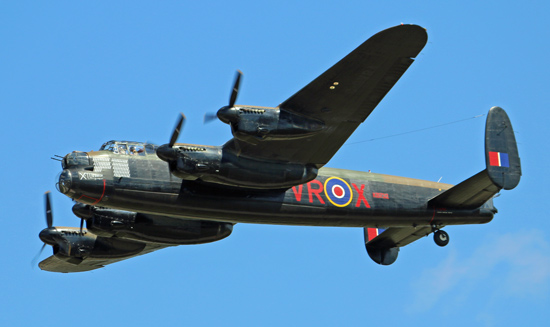|

Avro Lancaster owned and flown by the Canadian Warplane
Heritage Museum.
(Photo by Buck Wyndham, Copyright 2015.)
History:
When the United Kingdom's Bomber Command was given the difficult missions of destroying
German dams in the Ruhr valley and sinking the Bismarck-class battleship Tirpitz in a
Norwegian fjord, their aircraft of choice was the Avro Lancaster
heavy bomber. With four Rolls-Royce Merlin engines giving a top speed of 287 mph and a
range of 1,660 miles, the Lancaster’s’ seven-man crew could provide a knockout
punch with a typical load of 18,000 pounds of high explosive over the target. Along with
the Handley Page Halifax, the Lancaster gave the UK the offensive striking power needed to
penetrate German air defenses during World War II. As Winston Churchill instructed the Air
Ministry in 1942, the UK must "…make sure that the maximum weight of the best
type of bombs is dropped on [Germany] by the aircraft placed at their disposal."
Entering service at the beginning of 1942, the
Lancaster’s design grew out of a failed predecessor, the Avro Manchester. While
its’ airframe offered a stable platform for heavy bombing assignments, the
Manchester’s twin engine design was inadequate to the task. By upgrading to four
Merlins, the resulting aircraft met the nation’s needs and 7,366 Avro Lancasters were
built during the war, the most of any British bomber. Armament included eight to ten
Browning machine guns for fighter defense (depending on model variant) mounted in the
nose, upper dorsal turret and the tail. Experience with a variety of bomb loads eventually
led to adoption of the ‘Grand Slam’ 22,000-pound bomb, the largest carried by
any aircraft in the war. For the dam-busting strike in May 1943, the Lancaster dropped
British designer Barnes Wallis’s ‘bouncing bombs’ which skipped on the
surface before impact. Wartime Lancaster sorties totaled about 156,000 during which
roughly 608,000 tons of ordnance were dropped on the enemy.
As the war in Europe drew to a close, the Lancaster was
readied for service against Japan as part of Bomber Command’s ‘Tiger
Force’, but the war’s end put a halt to this plan. Apart from its primary
bombing tasks, the versatile Lancaster was also used for maritime surveillance, photo
reconnaissance missions and, later, as an engine test bed platform. The final airframe was
delivered in February 1946, but the plane flew for many years in civilian guise and as a
warplane when sold to other nations. A number of Lancasters were preserved and still can
be viewed at museums, but only two still fly -- one in
Canada and one in the UK.
Nicknames:
"Lanc"
Specifications (Lancaster Mk I):
Engines: Four 1,460 hp Rolls-Royce
Merlin XX inline piston engines.
Weight: Empty 36,900 lbs, Maximum
Takeoff 68,000 lbs.
Wingspan: 102 ft 0 in.
Length 69 ft 6 in.
Height: 20 ft 0 in.
Performance:
Maximum Speed at
12,000 ft: 287 mph
Service Ceiling:
24,500 ft
Range with
14,000 pound load: 1,660 miles
Armament:
Two 0.303-inch
(7.7mm) guns in nose, ventral and dorsal turrets.
Four 0.303-inch
(7.7mm) guns in tail turret.
Fourteen 1,000
pound bombs.
Crew: 7
Number Built: 7,366
Number Still Airworthy: Two
Links:
Avro Lancaster Heavy Bomber --
Photos and information about surviving Lancasters.
Battle of Britain Memorial Flight
(BBMF) Lancaster, UK
Canadian Warplane
Heritage Museum's Lancaster page -- Mount Hope, Ontario, Canada.
CNAPG Lancaster page
Lancaster KB882 Restoration
-- Edmunston, New Brunswick, Canada.
LancasterRestoration.com --
Nearly 21,000 Lanc drawings available online.
Linclonshire Lancaster
Association, UK
Nanton Lancaster Society and Museum,
Canada

[ Click for more great books about
the Lancaster! ]

[Back to Warbird Alley's Main
Page]
All text and photos Copyright 2016 The Doublestar Group, unless otherwise noted.
You may use this page for your own, non-commercial reference purposes only.
 |